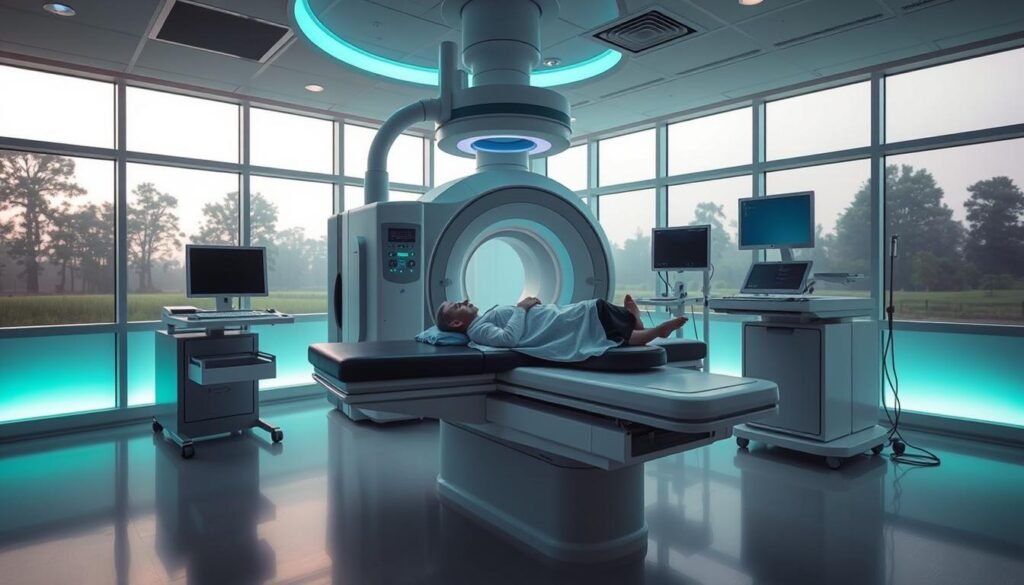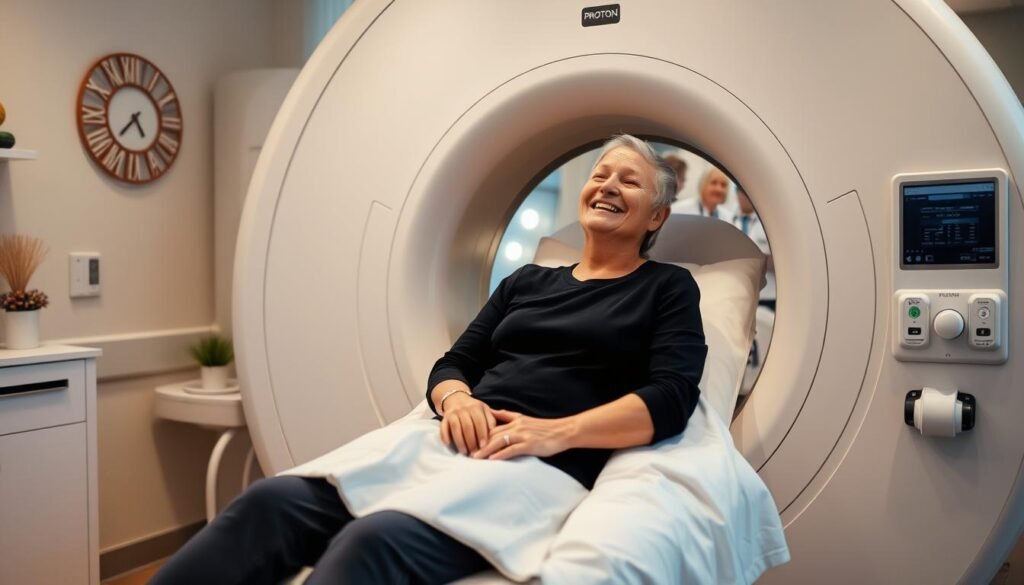In 2013, 159,480 Americans lost their lives to lung cancer. This fact highlights the critical need for new treatments. Proton therapy for lung cancer stands out as a key advancement. It targets tumors accurately and protects important body parts nearby.
Proton therapy is a big step forward in cancer care. It delivers focused radiation, reducing harm to healthy tissues nearby. Studies suggest that using proton therapy with chemotherapy improves survival rates. It also betters the quality of life for lung cancer patients.
Research is always moving forward, looking into how this treatment can help with other cancers too. Knowing the benefits of proton therapy is key for those affected by lung cancer. Discover more at MD Anderson Cancer Center.
Key Takeaways
- Lung cancer is a leading cause of cancer-related deaths in the U.S.
- Proton therapy provides targeted radiation that spares healthy tissues.
- Combining proton treatment with chemotherapy may enhance survival rates.
- Recent studies indicate reduced toxicity with proton therapy compared to traditional methods.
- Ongoing research explores the efficacy of proton therapy across various cancer types.
Understanding Lung Cancer
Lung cancer is a serious health issue with many types. It comes in two main forms: non-small cell lung cancer (NSCLC) and small cell lung cancer (SCLC). NSCLC makes up about 85% of all cases. It includes types like adenocarcinoma, squamous cell carcinoma, and large cell carcinoma. SCLC is rarer but more aggressive, often linked to smoking.
Types of Lung Cancer
Knowing the different lung cancer types helps doctors plan treatments. They can choose specific treatments based on the cancer type and the patient’s health. NSCLC grows slower than SCLC. So, not all cases need quick, aggressive treatment.
Statistics and Survival Rates
Lung cancer statistics show the need for new treatments. Only about 24% of patients live five years after diagnosis. This makes lung cancer a top cause of cancer deaths worldwide. Early detection and the cancer stage at diagnosis affect survival rates lung cancer a lot. Early-stage lung cancer has much better survival rates.
Thanks to technology and new treatments, patients’ futures are looking brighter. It’s important to understand lung cancer well and seek treatment early.
Introduction to Proton Therapy
Proton therapy is a cutting-edge cancer treatment. It uses high-energy protons to target tumors precisely. Unlike older therapies, it offers significant benefits for treatment results.
What is Proton Therapy?
Proton therapy sends radiation right to the cancer while keeping nearby healthy tissue safe. It doesn’t scatter radiation like older methods because of how protons behave. Thanks to something called the Bragg peak effect, radiation doses peak at the tumor site. This is especially good for cancers near important parts of the body, like the lungs.
Comparison to Traditional Radiation Therapies
When we compare proton to photon therapy, proton therapy’s advantages stand out. Here are the main differences:
| Feature | Proton Therapy | Traditional Radiation Therapies |
|---|---|---|
| Treatment Precision | High precision, targets tumor directly | Less precise, can affect surrounding tissues |
| Radiation Exposure to Healthy Tissue | Minimal exposure | Higher exposure |
| Potential Side Effects | Reduced side effects | Increased risk of side effects |
| Cumulative Treatment Time | Typically 15–30 minutes per session | Varies, often more time-consuming |
| Costs | Generally higher | Usually lower |
Studies show that proton therapy can lead to better outcomes for some tough cancers, like advanced lung cancer. In the last 28 years, it’s helped over 190,000 patients around the world. This experience is driving new innovations in treating lung cancer.
The Physics Behind Proton Treatment for Lung Cancer
Understanding how proton therapy works is key to see its benefits for lung cancer. Proton interactions with tissues are not like traditional X-ray effects. This is because protons have a unique trait, such as the Bragg peak. Their energy distribution also plays a big role.
Bragg Peak and Energy Distribution
The Bragg peak marks where protons unleash most energy right at the tumor. This targets lung cancer cells well and spares healthy tissues around them. As protons move through the body, they slow down until they reach the Bragg peak.
This pattern of energy loss helps cut down on side effects from radiation, which is vital for lung cancer treatment. Plus, proton therapy doesn’t affect cells past the tumor, keeping them safe from radiation.
Particle Physics and Radiation Interaction
Particle physics lung cancer explains proton-tissue interactions in treatment. Proton therapy gets more precise with tools like Intensity Modulated Proton Therapy (IMPT). This, alongside Pencil Beam Scanning and 3-D Cone Beam CT, focuses with less than a millimeter precision. This significantly lowers doses received by healthy tissues at the entry point.
This level of control means patients mostly have fewer side effects than with traditional radiation. Hence, they might have a better experience and outcomes might improve.
More and more, proton therapy is praised for how well it works on various cancers, lung cancer included. Its future looks bright with ongoing studies and use in clinics. To learn more about reducing proton therapy side effects, visit here.
Advantages of Proton Therapy for Lung Cancer
Proton therapy offers many benefits in treating lung cancer. It is more precise and has fewer side effects than old treatments. Because it can target tumors accurately, it’s great for lung cancer near vital organs like the heart and esophagus. These advanced methods help patients feel better and heal faster.
Precision Targeting of Tumors
Proton therapy is known for hitting cancer right on the mark. It uses a method called pencil beam scanning. This means doctors can match the therapy shape exactly to the tumor. By doing this, healthy tissues around the cancer are safe. This is key for treating the tumor well without hurting other organs.
Reduced Toxicity to Surrounding Tissues
Proton therapy is less harsh on the body than older treatments. It’s very good at keeping radiation from healthy tissues. This means patients won’t feel as sick from the therapy, now or later. Studies show it’s better for the heart and other organs. This makes it a top choice for fighting lung cancer.
Clinical Applications of Proton Therapy
Proton therapy is becoming a key player in cancer treatment, especially for lung cancer. It precisely targets tumors while saving healthy tissues. Because of this, it’s becoming more common in treating localized cancers.
Use in Non-Small Cell Lung Cancer
Proton therapy is especially good for treating lung cancer. It focuses radiation just on the tumor, protecting other organs. Modern technology, like pencil beam scanning, makes it even more precise. Studies, like those in an official publication, show it helps patients live longer.
Combining Proton Therapy with Chemotherapy
Chemotherapy and proton therapy together can work better for advanced cancer. This approach improves survival chances with fewer side effects. Doctors use this data to make sure each patient gets the best possible care.
| Parameter | Proton Therapy | Traditional Radiation Therapy |
|---|---|---|
| Tumor Targeting Precision | High | Moderate |
| Impact on Surrounding Tissues | Minimal | Significant |
| Average Treatment Duration | 30 minutes | Varies |
| Clinical Locations Available | Limited (e.g., MSK) | Widespread |
| Recent Patient Count at MSK | Over 2,000 | N/A |
Proton therapy is always getting better, offering new ways to fight cancer. It’s particularly promising for lung cancer patients. As studies go on, we’ll learn even more about combining it with chemotherapy.
Proton Treatment for Lung Cancer: Safety and Efficacy
Proton therapy is gaining traction for lung cancer treatment. Its benefits have been seen in clinical studies. These studies show patients getting better with fewer side effects.
Clinical Studies and Outcomes
In a study, proton therapy caused fewer severe side effects than traditional radiation. Only 12% of proton therapy patients had severe complications in 90 days. In contrast, 28% did in the traditional radiation group. This shows how safety proton therapy is important, especially for those with existing health concerns.
Proton therapy also helps patients maintain their quality of life. Patients had a lower risk of losing functional abilities. Additionally, cancer-free rates after three years were close between the two groups. 46% for proton therapy and 49% for traditional. The survival rate was similar too, with 56% for proton therapy and 58% for traditional after three years.
For LS-SCLC, proton therapy shows good control and survival rates. Combining chemotherapy with thoracic particle radiation proved effective. For more details, check the study from the New York Proton Center here.
Treatment Side Effects
Even with its safety, proton therapy can cause fatigue and skin irritation. These effects depend on where the treatment is applied. Still, the rate of severe side effects is low. This makes proton therapy a strong choice for those wanting effective treatment with less impact on health.

There’s ongoing research on proton therapy’s efficacy and safety. Continuous studies aim to improve lung cancer treatments. They focus on better patient outcomes and quality of life.
Latest Advances in Proton Therapy Technology
Recent tech changes have greatly improved proton therapy for lung cancer. The focus is on precise and effective treatment. This helps patients have better results with fewer side effects.
Pencil Beam Scanning
Pencil beam scanning is a key advance in proton therapy. It controls the proton beam’s delivery in detail, layer by layer, based on tumor size. This is especially good for lung tumors that move with breathing.
Research shows pencil beam scanning for lung cancer leads to better tumor targeting. It lowers damage to nearby healthy tissues. This method enhances treatment for non-small cell lung cancer patients. It shows the recent advances in proton therapy.
Gated Breathing Techniques
Gated breathing technology has been woven into proton therapy. It makes sure radiation is only given during certain parts of the breathing cycle. This cuts down exposure to healthy tissues and raises treatment accuracy.
Using these techniques, doctors can give more radiation to the tumor while lowering traditional therapy risks. The use of gated breathing technology in proton therapy is a big leap in lung cancer care. It makes treatment safer and more effective.
| Technology | Benefits | Impact on Treatment |
|---|---|---|
| Pencil Beam Scanning | High precision, reduced damage to healthy tissues | Improved targeting of lung tumors |
| Gated Breathing Technology | Increased accuracy in radiation delivery | Minimized side effects, enhanced patient safety |
These advancements show how important innovation is in proton therapy. They lead to a future where lung cancer treatment gets better results with lower risks. For more about proton therapy, check the study here.
Cost Considerations of Proton Therapy
Choosing proton therapy for lung cancer means looking closely at costs. This advanced treatment is often pricier than standard radiation. This is due to its specialized tech and the facilities needed.
Understanding these costs is key. It looks at how they impact both patients and healthcare systems. This helps in making an informed decision.
Comparative Costs with Other Treatments
Prices for proton therapy can vary a lot. They range from $25,000 to more than $100,000 at places like the Oklahoma Proton Center. It’s usually more expensive upfront than other radiation methods like 3DCRT and IMRT.
A study showed it could be three times more than EBRT. This is due to setup and running costs. But, there can be less side effects, which might save money over time.
Insurance Coverage and Accessibility
Insurance for proton therapy is getting better. At some centers, 80% of patients get their treatment covered. Medicare offers about $1,000 per session, leaving a 20% co-pay for patients.
While coverage is improving, it’s not the same everywhere. Pushing for wider insurance acceptance is crucial. It will help more people get this treatment as healthcare costs rise.

Future Directions for Proton Therapy Research
The ongoing evolution of proton therapy aims to boost its use for treating lung cancer. Researchers are working hard to improve how it’s used and find new ways to apply it. They’re looking into how to best adjust doses and mix it with other treatments.
They want treatments to fit each patient’s unique needs better. This would make proton therapy an even more crucial choice for battling lung cancer.
Emerging Clinical Trials
Emerging clinical trials for lung cancer are looking at patients from all walks of life. They want to see how well proton therapy works. Especially for those with advanced stages of the disease, highlighting flaws in current treatments.
It’s key to research how it can work alongside other treatments. This will ensure future methods are more effective.
Improving Treatment Protocols
As more people notice proton therapy, research into how it’s given is growing. The goal is to help patients live longer with fewer bad side effects. By bettering how treatments are done and exploring new clinical trials, proton therapy’s future looks bright.
Patient Experiences and Testimonials
Lung cancer treatment is a tough journey. It teaches patients a lot, especially when they choose proton therapy. Their stories are filled with hope and strength, shining a light on this advanced treatment.
Stories of Survivorship
Kathleen Norris’s story stands out in the world of proton therapy. She was the 100th patient to get it at MedStar Georgetown University Hospital. Kathleen went to treatment five days a week for six weeks alongside chemotherapy. She shared how proton therapy saved her healthy lungs and heart from damage.
Stories like hers show the power of facing cancer with advanced treatments. They give patients a sense of control over their health journey.
Impact on Quality of Life
Proton therapy makes life better for many by reducing side effects. It cuts down radiation to the body by half but still attacks the cancer fully. This lessens the chance of getting heart problems later.
Pencil-beam scanning technology makes this treatment very precise, up to millimeters. This leads to better health and motivates others to consider proton therapy.

| Patient | Treatment Duration | Radiation Exposure Reduction | Heart Risk Reduction |
|---|---|---|---|
| Kathleen Norris | 6 weeks | Up to 50% | 7.4% per gray |
| Anonymous Patient A | 8 weeks | 40% | 6.5% per gray |
| Anonymous Patient B | 7 weeks | 45% | 7% per gray |
These stories help us fully understand proton therapy’s benefits. They go beyond medical facts to show a powerful personal journey. Sharing these experiences lights the way for others thinking about this treatment.
Conclusion
The way we treat lung cancer is changing, thanks to proton therapy. This method is precise. It targets tumors without harming the healthy tissue around them. Studies show it works well for a certain kind of lung cancer. It’s a strong option versus traditional treatments.
As research moves forward, treatments are becoming more personal and effective. This is good news for patients. Reports show people are living longer and without their cancer coming back as quickly. This shows how proton therapy plays a big role in treatment plans. Plus, it doesn’t cause many severe side effects. So, patients can maintain a good quality of life while they fight cancer.
Treatment today includes focusing on each patient’s needs. This means they get the support they need while healing. With more amazing results from studies, using proton therapy for lung cancer is expected to grow. It offers new hope for those facing this tough disease.